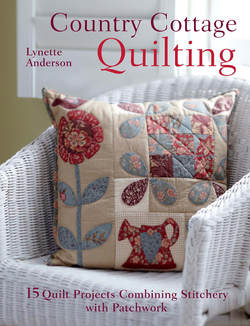Читать книгу Country Cottage Quilting - Lynette Anderson - Страница 10
На сайте Литреса книга снята с продажи.
ОглавлениеGardener’s Scissor Keeper
This scissor holder is padded with wadding and is perfect for keeping your scissors safe. Personalize the stitchery design by stitching your name above the little bird, either freehand or using the alphabet template at the back of the book.
You will need…
• Dark brown print for back and lining 8in (20.3cm) square
• Cream textured fabric for stitchery 5in (12.7cm) square
• Fusible stabilizer 5in (12.7cm) square (optional)
• Stranded embroidery cotton (floss): ginger, salmon pink, dirty mauve, black, aged red, moss green, grey and petrol blue (I used Cosmo threads but DMC equivalents are suggested in the instructions)
• Thin card
• Clear, fast-tack craft glue
• Thin wadding (batting) or fusible interfacing
• Template plastic
• Fine-tipped fabric marking pen in brown
• Light box (optional)
Finished size:
21⁄2in × 4in (6.3cm × 10.2cm)
Working the stitchery
1 Use the relevant templates given in Templates at the back of the book. Transfer the stitchery design for the scissor keeper on to the right side of the cream textured print, leaving at least 2in (5cm) between the designs to cut them apart later. Follow the instructions at the end of the Hollyhock Cottage Bag for stitching the designs.
Making the scissor keeper
2 Make templates from template plastic for the two scissor holder shapes. Place the templates on to the wrong side of your stitchery and, making sure that you have centred the stitchery, draw around the template with a pencil. Cut out these shapes, cutting out about 3⁄8in (1cm) beyond the drawn line to allow for a seam. Use the same templates to mark the shapes on your print backing fabric, cutting out about 3⁄8in (1cm) beyond the drawn line to allow for a seam.
3 Use the templates to mark the shapes on thin wadding (batting) but this time no seam allowance is needed, so cut out the shapes exactly on the line. Use the templates to mark the shapes on thin card, cutting out the shapes exactly on the line. Cut two card pieces for each shape.
4 Take one card back piece and one card front piece and use fast-tack glue to stick thin wadding on to one side of each of them.
5 Place the stitchery for the front of the scissor keeper wrong side up and place the appropriate card shape on top, wadding side up. Carefully put glue around the edge of the card and then bring the 1⁄4in (6mm) seam allowance over the edge on to the glue (Fig 1). Hold in place while the glue is drying. Do the same for the other piece of stitchery and the back piece of card. Repeat this process with the other pieces of card and the backing fabric pieces. Place these four pieces aside for the moment.
Tip
To ensure that the stitchery is centred on the card, hold the stitchery up to bright light with the card shape behind – you will be able to see if you have it in the correct place.
Making the tassel and cord
6 To make the tassel, cut a piece of card 11⁄4in (3.2cm) wide. Cut petrol blue and ginger stranded cotton, each about 30in (76.2cm) long and wrap them around the card about twenty times. Slide the tassel carefully off the card.
7 To make the cord, take petrol blue and ginger stranded cotton, each about 48in (122cm) long. Anchor one end of the threads under something heavy or ask a friend to hold one end. Twist the threads in a clockwise direction until the cord wants to double back on itself, but don’t let it yet! Thread the twisted cord through the top loops of the tassel, centre the tassel on the cord and now let the cord double back on itself. Hold on to the ends while it twists and then tie a knot at the end to secure the cord. Cut through the bottom loops of the tassel. Take a short length of thread and wrap it around the tassel about 1⁄4in (6mm) from the top loop. Secure with a knot and put the thread ends out of sight.
Assembling the scissor keeper
8 Take your four pieces of covered card and check that the glue has dried. Place the front pieces wrong sides together and glue together. Repeat the process with the two back pieces but first place the end of the twisted cord in the centre top between the two back pieces. You now have a back and a front for your scissor holder (Fig 2).
Tip
You could use washing pegs or bulldog clips to hold the scissor keeper layers together while the glue is drying, to ensure they bond well.
9 Using two strands of ginger stranded cotton and herringbone stitch, join the front and back pieces together, stitching the seam of the top front edge of the scissor holder (Fig 3). Now join the front to the back, stitching all around the edge to finish the holder.
